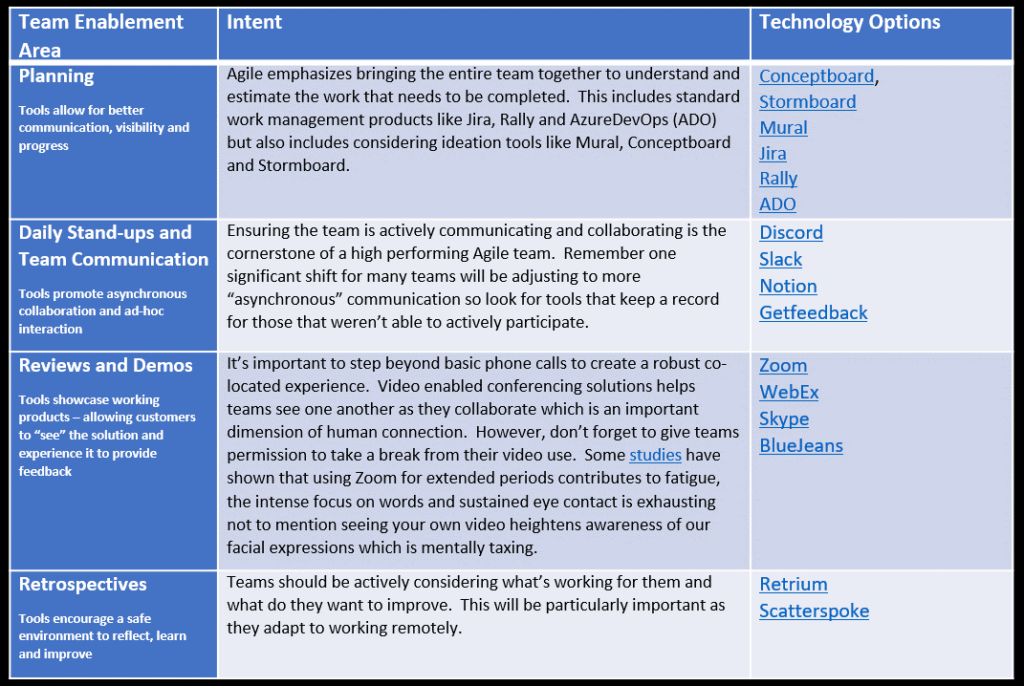How to Allow Agile to Thrive in a Virtual Environment
by Bryan Campbell and Bhavik Modi
Flashback to our digital lives in 2001 – Netflix was still mailing DvDs, Google was just getting started and Twitter, YouTube and Facebook didn’t exist. At the same time, only 50%[1] of people in the United States had cell phones and the iPhone was 6 years away. It was during these times that 17 software developers came together in Snowbird, Utah and created what they called the Agile Manifesto, a set of values and principles that would drive a revolution in how organizations and teams worked together to deliver business solutions.
Since the advent of the Agile Manifesto in 2001, practitioners have emphasized the importance of teams working together, side-by-side delivering valuable products for their customers. This is typically referred to as co-location and the benefits of teams working in the same location are numerous, from developing trust as they learn more about each other, to learning from “osmosis” as they hear colleagues collaborating to seeing shared goals and progress metrics through highly visible information radiators.
Collaboration is still as valuable as ever but 2020 is forcing us to revisit how to achieve the benefits of co-location without the co-location. The good news is that much has changed since the Manifesto was written which has created some answers to how to enable the benefits of being Agile. Here’s what you can do to allow Agile to Thrive in a Virtual Environment.
How to Enable Virtual Co-Located Teams
The first value of the Agile Manifesto states “Individuals and Interactions over Processes and Tools”, however, remote Agile teams are going to need effective technology or tools to emulate a co-located experience. Fortunately, technology and accessibility have improved significantly since the Agile Manifesto was developed and a number of options available today are free or low cost. As a leader, it is important to check to ensure that your team has access to core enabling tools to facilitate work management, brainstorming and ideation.
It’s likely your team interactions in a virtual environment are going to need some enhancements particularly during this extended time of remote work. Here are some areas that you should focus on and some starting technologies to consider:
Clickable Links at end of article
Create Your Agile Working Agreements
As teams shift to remote work, team members and companies will need to reconsider many of their working agreements. Team members will need to discuss how they want to engage using Zoom and other tools including what their expectations are in regards to responding to messages and video conferences. This might mean considering whether to invest in high speed internet, efficient and ergonomically appropriate work spaces and considering how to minimize distractions (including your chatty Macaw) from affecting your productivity. It might also be necessary to create some working agreements in your household on how to manage noise levels and interruptions and possibly some personal working agreements on stretching and the frequency of your visits to the pantry. Companies should reconsider how to their onsite gyms and offer memberships to Peloton or Steezy, instead of onsite cafeterias look to DoorDash or UberEats and start tracking the benefits to the environment of not having your employees driving to work.
Are We Having Fun Yet?
Agile also emphasizes creating a work environment that included having fun as a way to keep teams engaged. Ice cream retrospectives, jigsaw puzzle areas and plushy talking sticks are signals that this is an Agile team, so how do you insert fun into a virtual team setting? Once again there are some interesting options that have emerged that teams can consider. Try using one of the Jackbox.tv games that are easy to learn, team-oriented games accessible from phones, tablets and computers. Consider a virtual happy hour with the team and encourage everyone to share what they brought to the party. Another idea is a multi-player jigsaw game or maybe even create a Guild in an online game like World of Warcraft. You can even invite a llama to a team meeting through Goat-to-Meeting and support a community farm. Encourage the team to offer their own ideas too.
Three Moves You Can Make Tomorrow
It’s time to accept that Agile can and will work in a virtually distributed environment, so now you need to decide how to get the most out of it.
- Create Your Agile Technology Stack: Start with engaging your team and check to see if they have all the tools necessary to work effectively remotely.
- Enable Your Team’s Working Agreements: Create Working agreements with the team on how to engage with these tools and expectations on when and how frequently they should be used. Also teams need to check how they are setup in their home both from a technology and an ergonomics perspective. Small investments in keyboards, chairs and lighting can have big returns in productivity for companies and ergonomics for people.
- Lastly and most importantly Don’t Forget the Fun!
———————————————————–
Sources:
[1] https://www.infoplease.com/science-health/cellphone-use/cell-phone-subscribers-us-1985-2010
|
Team Enablement Area |
Technology Options |
|
Planning Tools allow for better communication, visibility and progress |
|
|
Daily Stand-ups and Team Communication Tools promote asynchronous collaboration and ad-hoc interaction |
|
|
Reviews and Demos Tools showcase working products – allowing customers to “see” the solution and experience it to provide feedback |
|
|
Retrospectives Tools encourage a safe environment to reflect, learn and improve |
